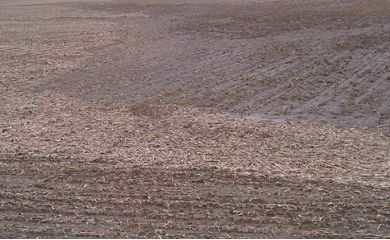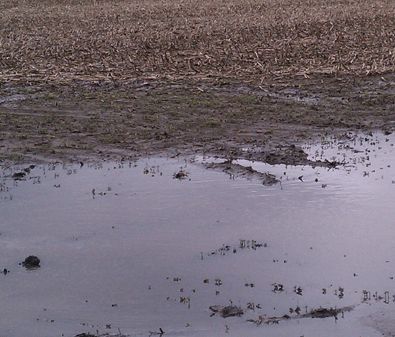Unintended Residue Movement Threatens Emerging Crops
Following hard rains last week, some growers are dealing with piles of wet residue covering young seedlings. In high run-off scenarios, cut residue moves in water and then piles up. In some situations, residue is up to 1 foot deep over the top of plants. While this situation can be difficult to resolve now, it can be avoided in the future.
If there's one thing I would like to see farmers reconsider, it's stalk chopping. Every year there are growers who have to deal with heavy rains washing stalks from fields to other areas where they bury plants, cover roadside ditches, or jam creeks. This can be avoided by leaving standing residue.
At this point the question is, how to quickly move or get rid of these wet residue piles before the plants underneath die. (See related story on plant survival.)
Remedial Actions to Eliminate Residue Piles

Fig 1. Residue washes down and collects in a natural waterway.

Fig 2. In this field both heavy residue cover and ponding water threaten survival of young seedlings.
If there is so much residue that plants can't reach light, growers need to get it off quickly.
In talking to my colleagues and several area farmers, burning was suggested as one solution for these piles. Burning, however, may only get the top most dry material while residue underneath is still wet and won't burn. Another farmer correctly pointed out that there's usually so much silt intermingled with the residue that it's hard to get a good burn anyway.
Keith Glewen, UNL Extension Educator in Saunders County, suggests harrowing or possibly rotary hoeing the stalks, depending on the depth of stalks and how much time has elapsed since a heavy rain. Harrowing can help even out the field and while emerged seedlings may be damaged, the growing point for corn is still below ground and the plant should survive minor injury.
For emerged beans, the growing point would be above ground so harrowing wouldn't be a good option. With the ongoing rains, I'm not even sure that harrowing is much of an option for corn as it will take a while to get back into the fields.
In the mean time, evaluate your operation and the need for chopping stalks. UNL on-farm research found no yield benefit to shredding compared with not shredding stalks. Read more about this on-farm research.
Source: University of Nebraska–Lincoln